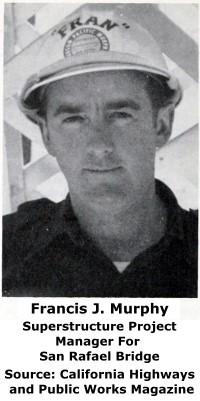We Recommend:
Bach Steel - Experts at historic truss bridge restoration.
BridgeHunter.com Phase 1 is released to the public! - Visit Now
Richmond - San Rafael Bridge
John F. McCarthy Memorial Bridge

Primary Photographer(s): Nathan Holth
Bridge Documented: April 7, 2013
Richmond and San Rafael: Contra Costa County, California and Marin County, California: United States
Metal Cantilever Rivet-Connected Warren Through Truss, Fixed and Approach Spans: Metal 8 Panel Rivet-Connected Warren Deck Truss, Fixed
1956 By Builder/Contractor: Judson Pacific Murphy-Kiewit and Engineer/Design: Norman C. Raab
Not Available or Not Applicable
1,087.0 Feet (331.3 Meters)
21,346.0 Feet (6506.3 Meters)
72.2 Feet (22.01 Meters)
6 Main Span(s) and 137 Approach Span(s)
28 0100

View Information About HSR Ratings
Bridge Documentation
View Archived National Bridge Inventory Report - Has Additional Details and Evaluation
View Historical Articles About This Bridge
View Engineering News-Record Historical Article About This Bridge
This extremely long bridge is less famous than some of the bridges in the Bay Area, but this is somewhat unfair and does not reflect how impressive this historic bridge truly is. Although it is relatively young with a 1956 construction date, it was still built with all the details that make earlier bridges significant and so much different from modern bridges. These details include the use of rivets as well as a majority of being being built-up in nature, and most of those built-up beams using lattice and battens (as opposed to plate with punched holes like many post 1950 riveted bridges). As such, the bridge looks older than it is, and despite its age, it accurately conveys the construction techniques of the first half of the 20th Century that all quickly died out in the second half of the 20th Century. Overall, the bridge is noteworthy for its length, variety of span types, and double-deck configuration. The bridge starts out as a single deck at each end, with the westbound lanes quickly elevating and moving over to run above the eastbound lanes. Three span types on the bridge are most noteworthy. At the ends of the bridge, deck plate girder spans can be found. After these spans, and in between the two main span segments, deck truss spans are present. Finally, the main spans are cantilever through truss spans, unusual because there are two cantilever truss sections separated by a series of deck truss spans. The cantilever sections define two navigation channels under the bridge. The intermediate deck truss spans between the cantilever spans have an unusual appearance because they do not maintain the high elevation of the channel spans, so the bridge has a sagging appearance at the ends. The overall bridge also has a broad and shallow curve at the western half of the bridge, and unusual photo opportunities can be had as a result of this curving. The main photo on this page is a good example, and more examples are in the photo gallery page.
The construction of the bridge was noteworthy because aluminum falsework was used to help erect the bridge. The aluminum falsework looked a lot like the actual steel truss spans of the bridge, and were composed of built-up beams.
The bridge has had seismic retrofits, but the overall truss retains good historic integrity with rivets and original materials retained on the bridge. The same cannot be said for the more famous Bay Area bridges.
Francis J. Murphy, pictured on this page, worked for the Judson Pacific-Murphy Company and was the Superstructure Project Manager for the San Rafael Bridge.
This bridge is tagged with the following special condition(s): Double-Deck
![]()
Photo Galleries and Videos: Richmond - San Rafael Bridge
Bridge Photo-Documentation
Original / Full Size PhotosA collection of overview and detail photos. This gallery offers photos in the highest available resolution and file size in a touch-friendly popup viewer.
Alternatively, Browse Without Using Viewer
![]()
Bridge Photo-Documentation
Mobile Optimized PhotosA collection of overview and detail photos. This gallery features data-friendly, fast-loading photos in a touch-friendly popup viewer.
Alternatively, Browse Without Using Viewer
![]()
Driving Over The Bridge
Original / Full Size PhotosA collection of photos taken with a wide angle GoPro camera showing the experiance of driving over the bridge. Photos from both the upper and lower deck are present. This gallery offers photos in the highest available resolution and file size in a touch-friendly popup viewer.
Alternatively, Browse Without Using Viewer
![]()
Driving Over The Bridge
Mobile Optimized PhotosA collection of photos taken with a wide angle GoPro camera showing the experiance of driving over the bridge. Photos from both the upper and lower deck are present. This gallery features data-friendly, fast-loading photos in a touch-friendly popup viewer.
Alternatively, Browse Without Using Viewer
![]()
CarCam: Westbound Upper Deck Crossing
Full Motion VideoNote: The downloadable high quality version of this video (available on the video page) is well worth the download since it offers excellent 1080 HD detail and is vastly more impressive than the compressed streaming video. Streaming video of the bridge. Also includes a higher quality downloadable video for greater clarity or offline viewing.
![]()
Maps and Links: Richmond - San Rafael Bridge
Coordinates (Latitude, Longitude):
Search For Additional Bridge Listings:
Bridgehunter.com: View listed bridges within 0.5 miles (0.8 kilometers) of this bridge.
Bridgehunter.com: View listed bridges within 10 miles (16 kilometers) of this bridge.
Additional Maps:
Google Streetview (If Available)
GeoHack (Additional Links and Coordinates)
Apple Maps (Via DuckDuckGo Search)
Apple Maps (Apple devices only)
Android: Open Location In Your Map or GPS App
Flickr Gallery (Find Nearby Photos)
Wikimedia Commons (Find Nearby Photos)
Directions Via Sygic For Android
Directions Via Sygic For iOS and Android Dolphin Browser
USGS National Map (United States Only)
Historical USGS Topo Maps (United States Only)
Historic Aerials (United States Only)
CalTopo Maps (United States Only)






